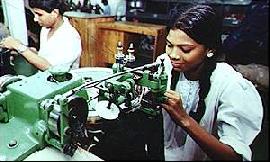 THERE is no way to disagree with the need for technology. In several instances, the need for technology have been discussed but so far progress is not at all appreciable. NSAPR II, in its supporting strategy-V on enhancing productivity and efficiency through science and technology mentioned that the country will be made a poverty-free and prosperous one through the application of science and technology. Innovative introduction of Information and Communication Technology (ICT) has also been given thrust in the strategy paper. In this knowledge-based economy, technology is the most sought after area where advancement is required. An integrated technology policy combining science, industry, innovation and technology is a must to increase investment and export in our country.
THERE is no way to disagree with the need for technology. In several instances, the need for technology have been discussed but so far progress is not at all appreciable. NSAPR II, in its supporting strategy-V on enhancing productivity and efficiency through science and technology mentioned that the country will be made a poverty-free and prosperous one through the application of science and technology. Innovative introduction of Information and Communication Technology (ICT) has also been given thrust in the strategy paper. In this knowledge-based economy, technology is the most sought after area where advancement is required. An integrated technology policy combining science, industry, innovation and technology is a must to increase investment and export in our country.
Knowledge is the main source to liberate people and empower them, ICT can help women empowerment. Enhanced access to technology goes in parallel. Women constitute about half of the total population. World Population will grow 9.5 billion by 2050, it means about 4.5 billion women need to be empowered. Women want to be financially independent Role of technology for mainstreaming women is very important.
A recent seminar on achieving Millennium Development Goals (MDGs): development and promotion of handbook on technology for women organised by D-net highlighted the need for technology for women and showed different MDG targets, its reflection in the election manifesto and related issues to develop the situation. It also voiced a very important point that whether women for technology or technology for women or technology and women would be our target. It has been told that many of the MDGs may be achieved if women’s capacity to use technology in their daily life and at their workplace is enhanced. Presentation of D-net referring to NMG-3 mentioned that enrolment of women in the tertiary education is 0.53 where actually technology education starts, it is 1.04 in the primary level and 1.04 in secondary level compared to male children. Actually we need to define technology in respect of its use, perspective and affordability.
The handbook has given some examples of technologies which can be used by the field level workers to train women for safer and better life. It also explained some examples where ICT helped women to take income generating activities, e.g. telephone reception, mobile phone servicing, etc. All these issues have helped us to know some basic technologies that can be used by women to make their services comfortable and more useful. Technology for women is difficult as it gives some actual gain for women to build their capacities. How women will advance without technology? We are lagging behind in technology. Women as a backward segment are naturally in a much more disadvantaged situation.
Women have been given limited educational opportunities. They have been restricted by law from many activities, and excluded from professional societies and publications until the close to the end of last century. Over the past 100 years, these limitations have begun to be lifted and doors and minds have begun to open. The guide has also endorsed and referred several statistics of Gender Gap Index.
From history we can see that in some areas women were pioneers. The processing of foods also falls to women in most primitive societies. Grinding roots and grains requires technological development in the  form of tools, and storage of perishable food items requires the invention of processes such as drying, jerking, smoking, and pickling. Many foods which we take for granted, such as tapioca and olives, must be chemically processed just in order to be edible.
form of tools, and storage of perishable food items requires the invention of processes such as drying, jerking, smoking, and pickling. Many foods which we take for granted, such as tapioca and olives, must be chemically processed just in order to be edible.
Another field of prehistoric technology which probably fell to women was clothing. Preparation of hides, weaving, and sewing are all activities generally done by women in primitive cultures. Care for the young, the old, the sick and the injured may also have been the responsibility of women. Many food processing devices, for example, have been patented by women. In the nineteenth century, American women patented everything from apple peelers to mechanical mixers. Women traditionally have different levels of access to resources and control over resources. We do not have statistics to know about the differences of access to technology between men and women. The “Technology” as “Culture” perspective goes further than the current viewpoint of women’s exclusion from full participation in technological work. Some statistics shows that women are willingly or by nature have- been excluded. Technology has been defined prominently from a predominantly male perspective. Change comes through a total re-evaluation and appropriate remuneration of women’s skills and technical tasks. This is because male are supposed to take the burden of the family.
What is happening in Bangladesh and nature of participation of women in work? Women’s work participation rates have doubled in Bangladesh since 1995 but they are still extremely low at 26 per cent. The dramatic growth in women’s employment is led by the health and community service sector. Younger women’s employment has seen the largest increase. Higher education is an important predictor of both entry into the labour market and wages. Micro credit has had direct and indirect impact on employment. But only 10 per cent employed women and 22 per cent of employed men aged 20-55 receive any cash wages. Poor access to wage works also explains more generally why women choose to stay out of market.
Women entrepreneurs constitute less than 10 per cent of the total business entrepreneurs in Bangladesh whereas it is more than 25 per cent of all businesses. They are gaining strength for Bangladesh in the fields of micro credit, readymade garment and achieving other socio-economic indicators. The contribution of women in SME sector is 7 per cent but in India it is 20 per cent and in South East Asian countries the percentage is even much high. In 2007, the employment-to-population ratio for young women was 26.2 per cent compared to 57.2 per cent for young men.
Why are we technologically poor. Most of the LDCs are feeding developing countries with raw materials rather than adding value in them. In order to integrate a culture of innovation, enough work (lobbying) has to be done. We do not have technology policies: It is combination of industrial, science, technology and innovation policies. Industrial policies focus on production and outputs in quantitative terms. Science policies deal with supply of knowledge, and knowledge infrastructure, with outputs also being measured in  quantitative terms. Technology policies focus on competitiveness with enterprises on firm-level behaviour whereas innovative policies focus on dynamic process of change, adaptation, interaction and integration. Poor countries face the danger of exclusion from the global realm of development as a result of technological change that tends to marginalise small holders and the poor. Bangladesh is an example.
quantitative terms. Technology policies focus on competitiveness with enterprises on firm-level behaviour whereas innovative policies focus on dynamic process of change, adaptation, interaction and integration. Poor countries face the danger of exclusion from the global realm of development as a result of technological change that tends to marginalise small holders and the poor. Bangladesh is an example.
Innovative policy whether tacit or explicit play a role in setting the parameters within what actors make decisions. Innovative processes are not the outcome of a single policy but a set of policies that collectively shape the behaviour of actors. Technology policy of a country should be an integral part of other related policies. South Korea and Taiwan are examples of nations where they adopted interventionist strategies on trade and domestic resource allocation to promote indigenous entrepreneurs and strength the national economies. Exports in these countries were led by local firms, and national policies allowed them to build impressive technologies. The policies in these countries stimulated research and development. The building of technology support institutions and establishment of SMEs have helped them to go for innovation in technology. Government also helped them by establishing technology infrastructure and building capacities for the development of general and technical skills.
In the agriculture there is a danger for small producer being squeezed out by capital costs and high royalty payments need for certification etc. Women’s labour in agriculture has increased from 25 per cent in 2002-03 to 34 per cent in 2005-2006 (PRSP). Technology in these areas is one of the priorities for increasing production and rationalising use of limited resources. In agriculture, we cannot maximise production because of lack of post-harvest handling knowledge. We cannot assure standard quality in export market. Each year 50-55 per cent produce is being damaged resulting in increase in production cost that eventually affects in offering competitive prices in the market. Technology access is very important in that respect. The guidebook of D-Net has given some examples where small technology in the agriculture sector can be an income generating activities for women. There could be some technologies to be used for reducing of wastages in the agriculture sector.
We do not have any option but to develop technology. Bangladesh has potential resources for innovation and creation, but these opportunities were not properly nurtured with appropriate IP policy framework and institutions. Public sector plays a dominant role in research initiatives while private sector generally wants to use the research output without much involvement in the research endeavour. As a result of the existing dilemma, R&D fails to cater to the needs of the market demand. Major industrial sectors in Bangladesh like jute, RMG and pharmaceuticals could not grow properly due to absence of required research and development.
Technologies used in the country, irrespective of their public and private sectors identities, are mostly imported and the provision of technology transfer is extremely limited. Patent registration in the local level is insignificant. Whatever that may be, patent applications filed by the local firms are not any groundbreaking innovation. Private sector stakeholders are not confident in coming up with substantive R&D investment programmes. Apart from this, research-grants provided by the government to the public research institutions are not enough to meet the need. Scientists working behind these innovations are not properly valued and remunerated.
In the field of agriculture, the allocation of funds is a bit generous as the sector enjoys top priority in the context of ensuring food security. Sill, lots of researches have to be carried out to feed the growing number of population with limited land resources and to cater to the needs of growing agro-processing industries. In our case, importance of agriculture has several aspects Agriculture involves 48.4 per cent labour and contributes 20.87 per cent of the GDP, whereas industry employs 24.3 per cent contributing 29.66 per cent of GDP, service employs 14.2 per cent and contributes 49.46 per cent of the GDP. Meaning agriculture is contributing less but employing a huge swathe of population. Technology in this sector would need urgently to ensure standard of living and crop failures.
Malawi has formulated an input policy aimed at establishing structures for marketing of farmers’ produce. Malawi has some innovative project in the field of contract farming, formation of farmer association, adoption of market information system, cellular phone, establishment of community food banks etc. They are also trying for field school for farmers. They are also working for establishing linkage between farmers and agro producers.
Malaysia Technology Development Corporation (MTDC) offers special technology acquisition fund for Women (Thas, 2005). In India, Technology Development and Modernisation Fund and Credit Linked Capital Subsidy Scheme for technology upgrading of SME units have been formulated. Techno Girl Project of South Africa encourages girls in school to take science and maths to build their careers in engineering, science and entrepreneurship technology.
The winner of award for technology adoption: Owner of a chick firm is an example. She won the award for upgrading her business for manufacturing, slaughtering and cleaning chicken to instal an abattoir with high tech machinery. Another woman won award for using high tech machines for her garments Industry. In Bangladesh direct seeding technology has proved its worth. Technology for improving jute products and herbal medicines can give better results also.
In the Budget 2008-2009, the government has taken several steps to uphold the position of women. It allocated Tk. 1 billion to the SME Endowment Fund in FY 2007-08 to provide required assistance for the growth and development of SME sector in the country. In recognition of its great importance, a further allocation of Tk. 1 billion was given in the budget for FY 2008-09.
The government has allocated budget for women for providing allowances for the widowed, deserted and destitute women, for poor lactating mothers, and for poor lactating and working mothers in urban areas. Vulnerable group development (VGD) programme, rural employment and road maintenance programme (RERMP) etc. Some technology promotion fund can be allowed for women so that they are comfortable in their working environment.
In addition, funding for the SME refinancing scheme of Bangladesh Bank has been enhanced from Tk. 3 billion to Tk. 5 billion. But implementation of which is not up to the mark. So far taka about 50 million have been allocated (Jan 2009) through five scheduled banks and seven financial institutions of which nine are for industries, six for trade and five are for the services sector. Some portion of the fund can be used for technology promotion. Women are allowed to take this loan at bank rate at five per cent interest. Factoring is also allowed for women, which is not yet practices very much.
Banks are not interested in funding as most of the women are in proprietorship business. They need loan at the initial stage of their business but most of the banks’ requirement is to give loans after 2 years of starting business (e.g. Standard Chartered bank). Women require their own showroom, factory as precondition for getting fund (e.g. NCC bank). Tenant agreement in case of starting business from rental house, guarantor from government officer and spouse are some of the prerequisites which are barring women entrepreneurs from getting finance for banks. The special circular of Bangladesh Bank mentioned the Para-16, special advisory and service centre, but has not yet implemented it yet. Even if established, it is not equipped enough for disseminating information.
We can promote and encourage use and innovation of technology. Marketing of technology is also important so that it reaches to the appropriate segment of society. Technology fund and technology bank as has been developed by several developing countries is also important to encourage technology. We need to target export and export markets based on domestic technology as was done by the countries like Taiwan and South Korea. Technology institutions and infrastructure are not sufficient in our country to encourage technologies. Industry-University alliance is also required so that technology can be user-friendly.
Technology innovators should be rewarded Tacit and explicit technology use of traditional knowledge should be recognised and preserved with other policies. PRSP-action plans have to be integrated with other policies. Technology access for rural and urban women should be considered separately. Technology for women should not mean only kitchen technology to save women from drudgery of work.
Writer: Ferdaus Ara Begum
The writer is former Executive Director, SCCI
Source: The Financial Express